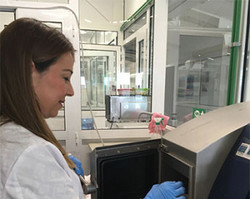
Andalusia seeks to achieve genetically enhanced sea bream third generation
Editor/Mohamed Shihab
The Undersecretariat of Agriculture, Fisheries and Rural Development of Andalusia, through the Institute of Agricultural Research and Training and Fisheries (IFAPA), is working on a research project to optimize new aquaculture techniques seeking to achieve the third generation of genetically improved sea bream.
Part of the genetics and genomics group at IFAPA centre El Toruño de El Puerto de Santa María (Cádiz) has participated in technology transfer activities in the facilities of the University of Las Palmas of Gran Canaria (ULPGC), focusing on analysis through near infrared spectroscopy (NIRS) of samples of the third generation of improved sea bream in the framework of this initiative.
According to IFAPA experts, sea bream, which is widely known in the world of aquaculture, has great potential in terms of development and production but requires innovative methods to do so. In recent years two generations of selection for growth have been carried out within this project, called Progensa III, and one previous one (Innotecss), but it is necessary to advance in the number of generations of selection as well as in the related characters with resistance to diseases, which are still unexplored.
The producing companies are really interested in the results of research projects such as Progensa-III, which aims to develop transferable methodologies for the gilthead seabream industry in Spain that will facilitate and standardize the implementation of genetic selection schemes in this species. This is carried out through the definition of characters of commercial interest with new technological developments as well as with the management of reproducers under the conditions of the industry to improve genetic progress per year and accumulated by generation.
For this reason, and to normalize the quality results of the gilthead seabream meat, the NIRS technique has been worked on with the samples obtained after the fattening periods of the third generation, based on the experience of the group from the University of Las Palmas de Gran Canaria, which increases the robustness of the data and minimizes environmental errors.
One of the objectives of the Progensa-III project is the production of a third generation of selected seabream for growth and morphology, based on populations of animals under industrial exploitation. For its evaluation, several producing firms in cages and estuaries have been involved in the farming project.
IFAPA, in particular, has collaborated with the company Pesquerías Isla Mayor, SL (Pimsa) to complete the fattening cycle in its facilities of brackish water estuaries in the province of Seville, in a coordinated manner with the cage companies located in the Canary Islands and Murcia.
Progensa-III project began in December 2016 and will end in October 2018, a month in which a transfer conference will be organized targeting the sector.


ساحة النقاش